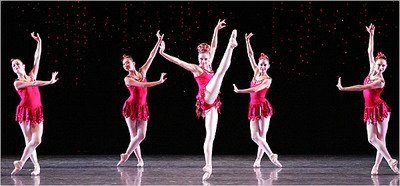As I seem to have fallen into the mode of recommending (I’ll fall out as soon as I can), let me recommend to you Edward Villella’s lovely, engrossing Miami City Ballet, in Manhattan for the first time after decades in the far reaches of Long Island and New Jersey. (The last time MCB was nearby, the dances’ magic competed with canned banter on all sides of me, as if my neighbors had dragged themselves reluctantly from their TVs, stale sit-com jokes clinging to them. In Manhattan and inner outer-borough theaters, there are also contests between the ridiculous and the sublime, though the form they take is different.)
Miami City Ballet’s “Rubies” (Photo by Joe Gato for Miami City Ballet)
In keeping with Villella’s own illustrious background as a New York City Ballet star and originator of many roles from the late ’50s into the ’70s, the two programs abound in Balanchine: “Symphony in Three Movements,” “La Valse,” “Square Dance,” “Rubies” from the full-length “Jewels,” and “Symphony in C”–every one of them glorious in its own way. (You’d be hardpressed to find a Balanchine that wasn’t.)
Villella’s dancers have a texture–a granular musicality, soft and thick–that transports you to where the air is distilled, condensed into art.
You know how people who grew up with Balanchine–the over-50 set–like to say, But you should have seen it back in the day? I get tired of hearing this, because I am seeing it now and it is often very much alive to me. But viscosity combined with clarity of steps isn’t the way people usually dance now. More often it’s either bright and sharp or soft and blurry. And while I believe Balanchine can accomodate many qualities, the ones Villella’s dancers favor really work.
The City Center engagement begins tonight and continues through Sunday.
If you aren’t in the New York area, your library may have “The Man Who Dances,” a 1968 documentary of Villella. He has to be seen to be believed.


Leave a Reply